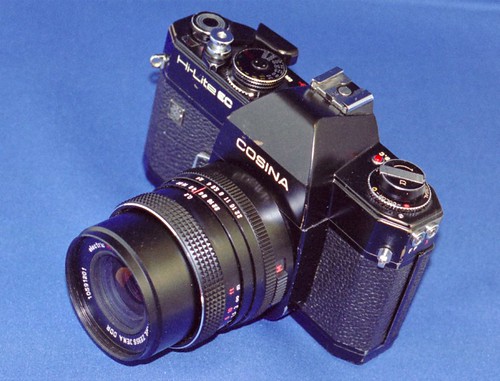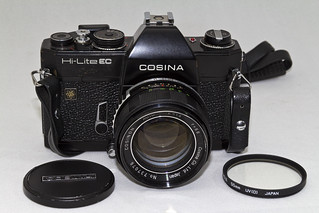Difference between revisions of "Cosina Hi-Lite EC"
m (Corrected heading) |
(reformatting page, rewriting with key features highlighted) |
||
| Line 1: | Line 1: | ||
| − | |||
| − | |||
| − | |||
| − | |||
| − | |||
| − | |||
| − | |||
| − | |||
| − | |||
| − | |||
| − | |||
| − | |||
{{Flickr_image | {{Flickr_image | ||
|image_source= http://www.flickr.com/photos/89864432@N00/309796958/in/pool-camerawiki/ | |image_source= http://www.flickr.com/photos/89864432@N00/309796958/in/pool-camerawiki/ | ||
| Line 18: | Line 6: | ||
|image_by= Uwe Kulick | |image_by= Uwe Kulick | ||
|image_rights= with permission | |image_rights= with permission | ||
| − | }}{{ | + | }} |
| + | The '''Hi-Lite EC''' is an innovative [[SLR]] from [[Cosina]] introduced in 1972.<ref>Page 229, {{McKeown12}}</ref> It is among the few models ever to offer aperture-priority autoexposure using plain-vanilla [[42mm screw lens | M42 screwmount lenses]]. | ||
| + | |||
| + | The shutter release plunger has a long travel, and partway through its stroke the lens stops down to shooting aperture and the metering circuit activates.<ref>This scheme returned with Cosina's later [[M42]] models the [[Cosina CSL | CSL]], [[Cosina CSR | CSR]], and [[Cosina CSM | CSM]]; but they are manual-exposure-only models unless the clunky & noisy motorized AEC adapter is attached.</ref> Fast-acting silicon blue photocells are able to read the scene illumination in the split-second before the user fully depresses the release button, and indicate the resulting shutter speed with a needle in the viewfinder. However there is no easy exposure compensation possible, aside from "lying" to the camera about the film's ASA/ISO speed. In this case the user can manually select a shutter speed different from the one indicated by the meter needle. | ||
| + | |||
| + | To return the viewfinder to its brightest image, a silver button on the front of the camera resets the lens to its widest aperture and deactivates the meter. | ||
| + | |||
| + | The autoexposure system is enabled with an electronically-timed vertically-traveling shutter which ranges steplessly from 2 to 1/2000 seconds. [[Flash sync]] is at 1/125th of a second. The shutter is dependent on power from the somewhat uncommon 6 volt silver-oxide battery, loaded through a cap on the back of the body; and there is a battery-check button to confirm the viewfinder needle reaches to or above the index mark in the center of the shutter-speed scale. | ||
| + | |||
| + | ASA or DIN are set using a collar below the shutter-speed dial. The collar around the rewind crank is simply a film-type reminder for the user, but does not connect to the meter system. There is a mechanical self-timer lever on the front of the body. | ||
| + | |||
| + | McKeown notes a '''Cosina Hi-Lite EC II''' adding a spot-metering option in addition to the averaging pattern, but we have not found it.<ref> Also said to be rebadged as the [[Vivitar 650 SLX]], a camera which indeed was [https://www.flickr.com/photos/vox/51160504912/in/pool-camerawiki announced] but may not have reached production. Page 229, {{McKeown12}}</ref> | ||
| + | |||
==Specifications== | ==Specifications== | ||
*Type: [[SLR]] body | *Type: [[SLR]] body | ||
| Line 33: | Line 33: | ||
*Power: Type 544 6V battery, battery control button, on/off-switch | *Power: Type 544 6V battery, battery control button, on/off-switch | ||
*Connectors: hot shoe and two other flash connectors | *Connectors: hot shoe and two other flash connectors | ||
| + | |||
| + | ==Notes== | ||
| + | <references/> | ||
==Links== | ==Links== | ||
*[http://www.kameramuseum.de/0-fotokameras/cosina/hi-lite-ec.html Hi-Lite EC] at [http://www.kameramuseum.de Kurt Tauber's] (in German) | *[http://www.kameramuseum.de/0-fotokameras/cosina/hi-lite-ec.html Hi-Lite EC] at [http://www.kameramuseum.de Kurt Tauber's] (in German) | ||
*[http://www.butkus.org/chinon/cosina/cosina_hi-lite_ce/cosina_hi-lite_ec-splash.htm User's manual] at Michael Butkus Jr.'s [http://www.butkus.org/chinon/index.html Orphan Cameras] | *[http://www.butkus.org/chinon/cosina/cosina_hi-lite_ce/cosina_hi-lite_ec-splash.htm User's manual] at Michael Butkus Jr.'s [http://www.butkus.org/chinon/index.html Orphan Cameras] | ||
| + | |||
| + | {{Flickr_image | ||
| + | |image_source= https://www.flickr.com/photos/mhilber/22081348914/in/pool-camerawiki/ | ||
| + | |image= http://farm1.staticflickr.com/604/22081348914_c506aaf876_n_d.jpg | ||
| + | |image_align= left | ||
| + | |image_text= | ||
| + | |image_by= Martin Hilber | ||
| + | |image_rights= nc | ||
| + | }} | ||
[[Category:Cosina|Hi-Lite EC]] | [[Category:Cosina|Hi-Lite EC]] | ||
Revision as of 12:14, 5 June 2021

|
| The Cosina Hi-Lite EC doesn't profit from the Zeiss lens's electric function image by Uwe Kulick (Image rights) |
The Hi-Lite EC is an innovative SLR from Cosina introduced in 1972.[1] It is among the few models ever to offer aperture-priority autoexposure using plain-vanilla M42 screwmount lenses.
The shutter release plunger has a long travel, and partway through its stroke the lens stops down to shooting aperture and the metering circuit activates.[2] Fast-acting silicon blue photocells are able to read the scene illumination in the split-second before the user fully depresses the release button, and indicate the resulting shutter speed with a needle in the viewfinder. However there is no easy exposure compensation possible, aside from "lying" to the camera about the film's ASA/ISO speed. In this case the user can manually select a shutter speed different from the one indicated by the meter needle.
To return the viewfinder to its brightest image, a silver button on the front of the camera resets the lens to its widest aperture and deactivates the meter.
The autoexposure system is enabled with an electronically-timed vertically-traveling shutter which ranges steplessly from 2 to 1/2000 seconds. Flash sync is at 1/125th of a second. The shutter is dependent on power from the somewhat uncommon 6 volt silver-oxide battery, loaded through a cap on the back of the body; and there is a battery-check button to confirm the viewfinder needle reaches to or above the index mark in the center of the shutter-speed scale.
ASA or DIN are set using a collar below the shutter-speed dial. The collar around the rewind crank is simply a film-type reminder for the user, but does not connect to the meter system. There is a mechanical self-timer lever on the front of the body.
McKeown notes a Cosina Hi-Lite EC II adding a spot-metering option in addition to the averaging pattern, but we have not found it.[3]
Specifications
- Type: SLR body
- Manufacturer: Cosina
- Year of launch: 1974
- Film: 35mm film with speeds 15 to 33 DIN
- Lens mount: M42 screw mount with aperture release mechanics
- Shutter: Copal electrically controlled focal plane shutter with speeds 1 sec. to 1/2000 sec. or B, or w/o battery: single speed
- Metering: TTL metering
- Exposure: shutter speed selected manually or controlled by meter
- Viewfinder: pentaprism finder, focusing aid on screen, ocular with frame for finder accessories
- Film advance: lever with analog exposure counter, rewind unlock button and rewind crank
- Dimensions: 145×99×53mm
- Power: Type 544 6V battery, battery control button, on/off-switch
- Connectors: hot shoe and two other flash connectors
Notes
- ↑ Page 229, McKeown, James M. and Joan C. McKeown's Price Guide to Antique and Classic Cameras, 12th Edition, 2005-2006. USA, Centennial Photo Service, 2004. ISBN 0-931838-40-1 (hardcover). ISBN 0-931838-41-X (softcover).
- ↑ This scheme returned with Cosina's later M42 models the CSL, CSR, and CSM; but they are manual-exposure-only models unless the clunky & noisy motorized AEC adapter is attached.
- ↑ Also said to be rebadged as the Vivitar 650 SLX, a camera which indeed was announced but may not have reached production. Page 229, McKeown, James M. and Joan C. McKeown's Price Guide to Antique and Classic Cameras, 12th Edition, 2005-2006. USA, Centennial Photo Service, 2004. ISBN 0-931838-40-1 (hardcover). ISBN 0-931838-41-X (softcover).
Links
- Hi-Lite EC at Kurt Tauber's (in German)
- User's manual at Michael Butkus Jr.'s Orphan Cameras

|
| image by Martin Hilber (Image rights) |